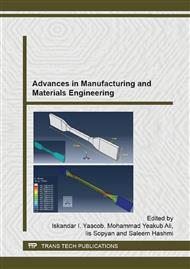p.357
p.361
p.369
p.373
p.378
p.382
p.386
p.390
p.394
Effect of Dispersants on Microstructures of Nano Alpha Alumina Developed from Aluminium Dross Waste
Abstract:
This paper compares the effect of dispersants which are Sodium Laureth Sulfate (SLS) and distilled water (DW) on the crystallization, particle size distribution and morphological behavior of nanoalpha Alumina (α-Al2O3) synthesized from Aluminium (Al) dross waste. The synthesizing of nanoα-Al2O3 via wet milling method was performed using a planetary mill for 4 hours at a speed of 550 rpm. The nanoα-Al2O3 powders with dispersants were characterized with x-ray diffraction (XRD), particle size analyzer (PSA) and transmission electron microscopy (TEM). XRD analysis shows the broadening and shifting of peaks after the sample was calcined at 1300 °C, indicating high crystallinity. The crystallite size of α-Al2O3 milled with SLS is also smaller than the α-Al2O3 milled with DW. These results are consistent with the PSA analysis in which the graphs displayed a symmetrical trend. Then, the PSA analysis is validated with TEM observation up to 100000x magnification, particularly for α-Al2O3 milled with SLS.
Info:
Periodical:
Pages:
378-381
Citation:
Online since:
July 2015
Authors:
Keywords:
Price:
Сopyright:
© 2015 Trans Tech Publications Ltd. All Rights Reserved
Share:
Citation:


